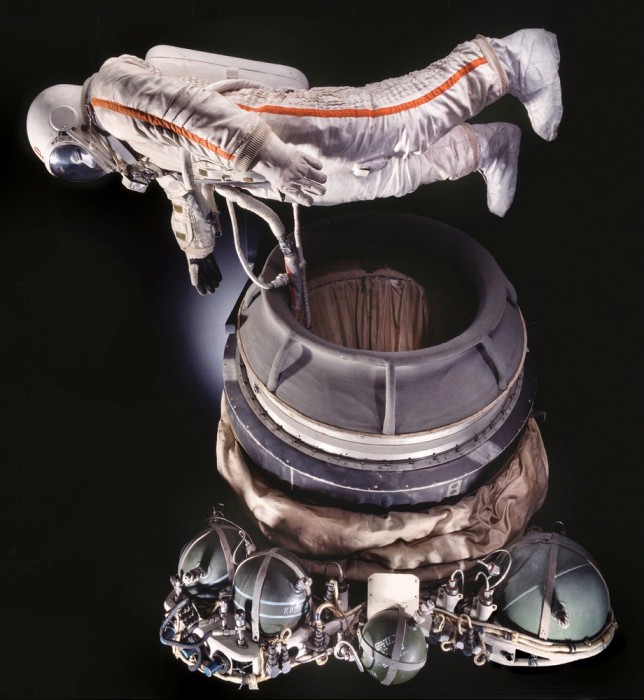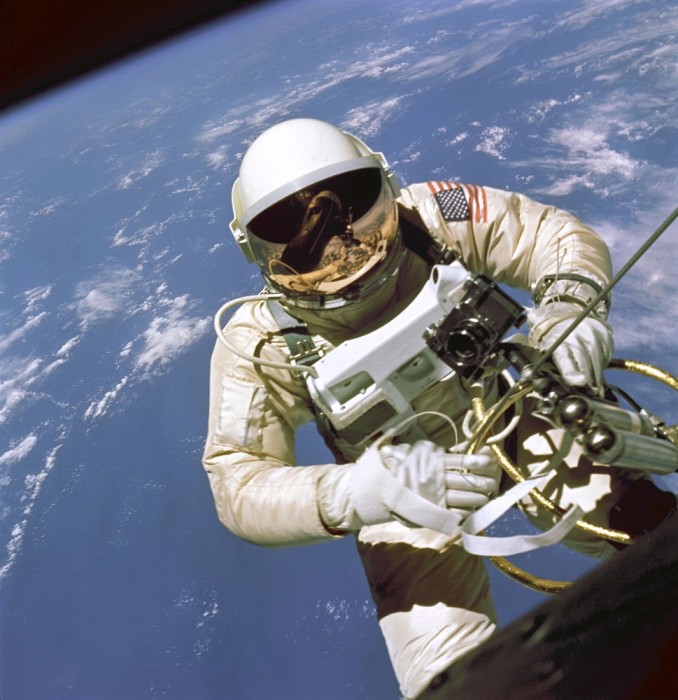In space, no one can see you sweat
This week marks the 50th anniversary of the first extravehicular activity (EVA), or spacewalk, made by Soviet cosmonaut Aleksei Leonov. The anniversary is a good time to look at how the United States and the U.S.S.R., locked in fierce competition to gain primacy in space, differed in their technological approach to sending a man outside the spacecraft. Don’t miss the exhibition Outside the Spacecraft for a detailed look at how astronauts are able to survive the lifeless void of space.
On March 18, 1965, Soviet cosmonaut Aleksei Leonov ventured outside his spacecraft and floated in space for about 10 minutes. He became the first human to float in open space. Because the Voskhod spacecraft in which Leonov was traveling with his commander Pavel Belayev operated with a full air environment, Soviet engineers faced the challenge of designing a spacewalk that would not require cycles of depressurizing and repressurizing the Voskhod 2. To this end, they opted for an external, inflatable airlock that would keep the Voskhod 2 pressurized for the duration of the spacewalk and minimize the extra air required for an emergency. This engineering solution complicated Leonov’s path to a spacewalk.

To allow a cosmonaut to leave the pressurized spacecraft, Soviet engineers designed a flexible airlock attachment. Once inflated in orbit, the airlock became a tunnel for exiting and re-entering the spacecraft, which remained sealed. Aleksei Leonov trained for his spacewalk in this airlock on display in the Air and Space Museum.
The cosmonaut had to make his way from and to the spacecraft through the 2.5-meter (8.2-foot) airlock. The protocol that Leonov and Belayev followed was detailed and well-rehearsed. But there were limits to what could be rehearsed on the ground. Leonov’s heart raced during his spacewalk and while the doublepressure layer of his suit retained his oxygen supply, it also retained every kilocalorie of energy that his body generated. His spacesuit contained physical restraints to prevent it from expanding, which made it stiff and unyielding. In order to regain flexibility in his suit, Leonov had to vent the air in his suit to lower the pressure. The fact that Leonov’s spacesuit had an air pressure gauge and air release valve indicates that Soviet spacesuit designers had an idea that Leonov might have trouble during his spacewalk. Leonov got even further excited as he reentered the airlock the wrong way after he finished his spacewalk. Instead of entering the long tube feet first, Leonov entered in the more instinctual manner of headfirst, forcing him to flip around inside the airlock and increasing his workload even further. In the end, Aleksei Leonov spent 12 minutes outside of the airlock, and an additional eight climbing through it. He returned to the Voskhod just as his ground link with the Kamchatka station (the Soviet’s farthest east station) began to fade.
In contrast to Leonov’s experience, astronaut Edward White had a pretty uneventful spacewalk almost three months later. The Gemini 4 mission was originally intended to be a test and maneuverability of the new Gemini spacecraft. In fact, the spacewalk was a late add-on for the flight. As late as 11 days before the flight, NASA had refused to commit to matching Leonov’s feat. While on the mission and after James McDivitt and White found they could not execute the rendezvous that they had planned after the initial orbit, they moved onto to the spacewalk. For them, the process was simple once they had contended with problems with the hatch and troubles with the voice communication system. Ed White was out in open space for 20 minutes. He used a handheld manned maneuvering unit to do maneuvers that Leonov had to self-propel through, and White also had the peace of mind of having McDivitt closely observing and photographing him during the outing.

Ed White performing the first EVA by an American during Gemini IV in 1965. Jim McDivitt took this photograph. (Credit: NASA)
Although the differences between the two experiences are often linked to Leonov’s difficulty in returning to the spacecraft and ascribed to a shortcoming in the spacesuit, that is not the case. In all likelihood, Ed White experienced a similar amount of increased stiffness of his spacesuit. He just had a larger opening and a clearer view to climb back into the spacecraft and had a less contorted path to return to his seat. In order to understand how both sides were facing the same technological issue, it is best to understand the physics of the two spacesuits. Leonov’s suit started with an initial operating pressure of 5.8 pounds per square inch and when he released pressure in the suit to reenter the airlock the suit reverted to a pre-set pressure of 3.9 psi. This had been the same operating pressure of the SK-1 Vostok suits that earlier cosmonauts had worn. Although this depressurization produced a dramatic change in the rigidity of his spacesuit, Leonov remained well within the limits of oxygen pressure for human lungs to function properly. Leonov’s suit was designed by engineers who knew that the minimum safe limit for the pressure of oxygen is 3.0 psi. Aleksei Leonov’s life was not at risk from venting pressure from his suit to allow hismto return to the Voskhod spacecraft. Any risk of decompression sickness (or “the bends”) had been averted by the fact that he and his commander Pavel Belayev had prebreathed oxygen prior to the spacewalk. In contrast, Ed White’s David Clark G4-C suit remained at a constant pressure of 3.7 psi of a pure oxygen environment.
The real technical flaw that these first spacewalks brought to light was the fact that neither side had an adequate cooling system for a spacesuit. By definition, spacesuits are airtight bags that hold air or oxygen. They do not conduct heat very well here on Earth. The cooling mechanisms of both the Soviet Berkut spacesuit and the American David Clark G4-C were even less adequate in the near vacuum of space. The Soviets had used a “heat sink” technology that channeled heat away from the body using an undergarment that was lined with small rubber cones that acted as radiators, moving heat from the skin’s surface to the inner layers of the spacesuit. The American astronauts relied on air-cooling for their spacesuits during Project Gemini. Both systems worked well enough for flights in the atmosphere or as long as the cosmonaut or astronaut remained inside a pressurized spacecraft. In a pressured capsule, those suits functioned well when exterior molecules could continue the cooling process by removing heat from the exterior layers of the suit through heat radiation. In the near vacuum of space, however, there are no molecules to do this, thus heat remained inside the suits and the humans inside overheated, the suits became rigid and simple tasks became exhausting and heroic feats.
As a result of the experiences of these first walks, both sides turned their attention to contemporary research at the Royal Aircraft Establishment at Farnborough in England. The year before the first spacewalks, British engineers D. R. Burton and L. Collier published the results of their research on developing “water conditioning suits” that promised to maintain a comfortable body temperature for aircraft pilots. The early suits were long underwear with flexible tubing through which cool water would circulate, thus removing heat energy from airtight suits. Within five years, all spacewalkers would wear some variation of this water conditioning suit now known as a Liquid Cooling and Ventilation Garment. Today, that is nearly the first thing that spacewalkers put on when preparing to work outside of a spacecraft regardless of whether they are wearing Russian, American or Chinese spacesuits.
A version of this post by Cathleen Lewis, curator in the Space History Department at the National Air and Space Museum, was originally published by AIRSPACEBLOG.
Posted: 19 March 2015




